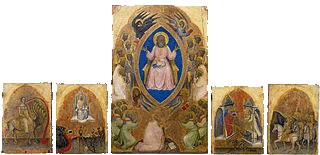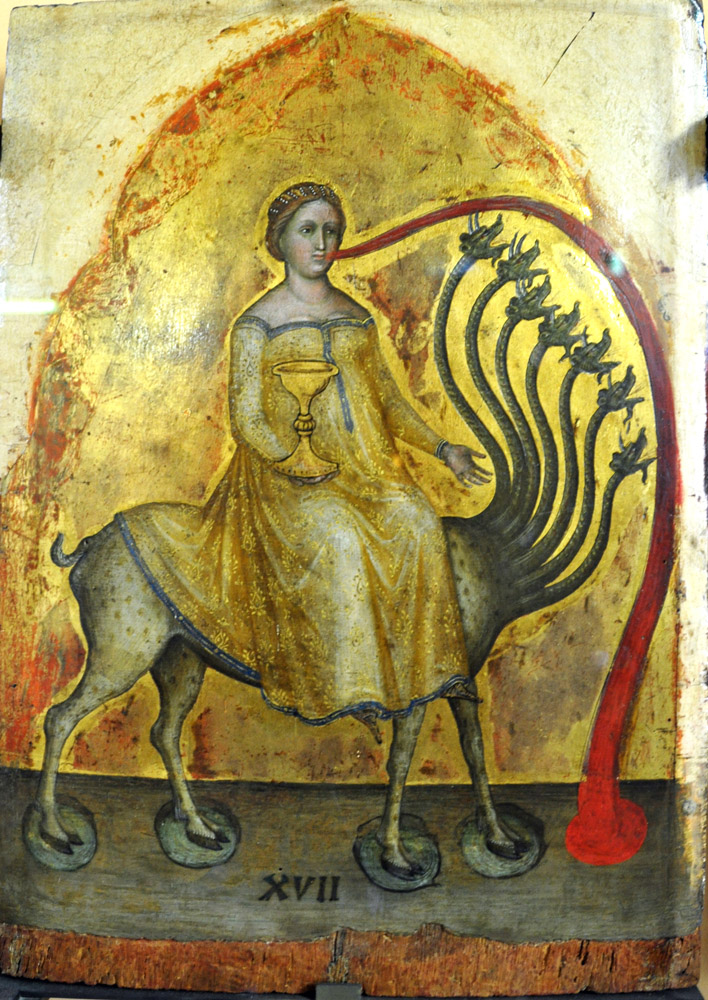 sitting upon a scarlet coloured beast, full of names of blasphemy, having seven heads and ten horns. And the woman was clothed round about with purple and scarlet, and gilt with gold, and precious stones and pearls, having a golden cup in her hand, full of the abomination and filthiness of her fornication. And on her forehead a name was written: A mystery; Babylon the great, the mother of the fornications, and the abominations of the earth. And I saw the woman drunk with the blood of the saints, and with the blood of the martyrs of Jesus."
sitting upon a scarlet coloured beast, full of names of blasphemy, having seven heads and ten horns. And the woman was clothed round about with purple and scarlet, and gilt with gold, and precious stones and pearls, having a golden cup in her hand, full of the abomination and filthiness of her fornication. And on her forehead a name was written: A mystery; Babylon the great, the mother of the fornications, and the abominations of the earth. And I saw the woman drunk with the blood of the saints, and with the blood of the martyrs of Jesus."
Alberegno suppresses details that would be difficult or ungainly to portray, such as the names on the beast and on the forehead. Still, he does get the golden cup, the seven heads, and even the ten horns. The flame (?) coming from her mouth could represent her drunkenness, or it could refer to the angel's later promise that the beast "shall eat her flesh, and shall burn her with fire" (17:16). The "xvii" at the bottom of the panel refers to chapter "17" of the Book of Revelation.
View full resolution.
Images photographed at the Accademia Gallery, Venice, by Richard Stracke, shared under Attribution-NonCommercial-ShareAlike license.
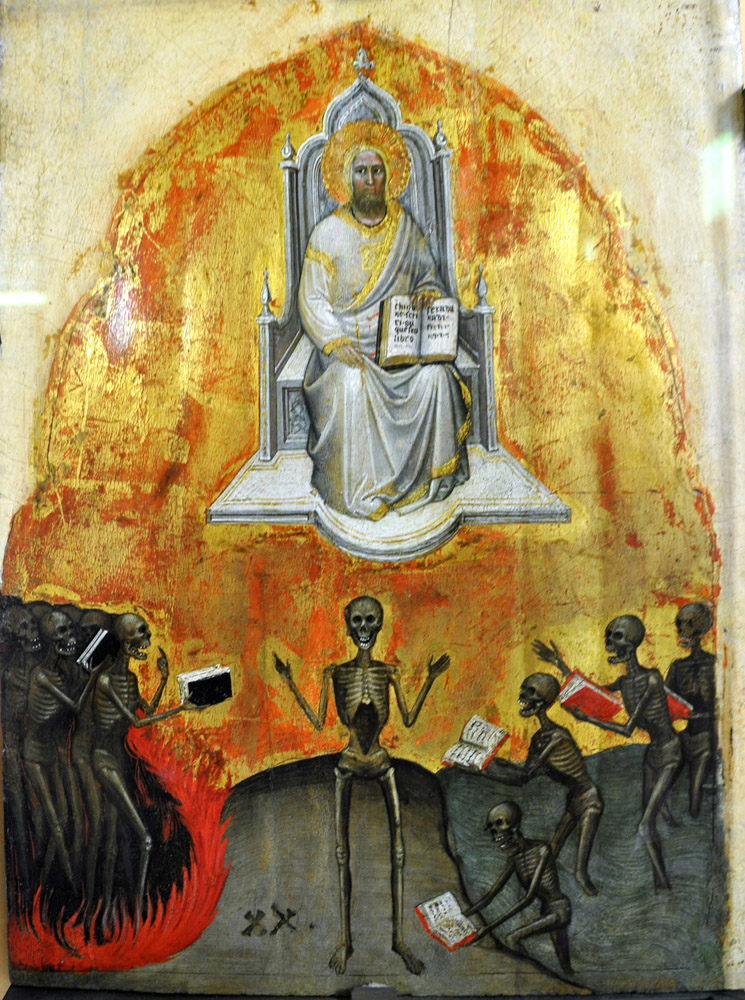 was no place found for them. And I saw the dead, great and small, standing in the presence of the throne, and the books were opened; and another book was opened, which is the book of life; and the dead were judged by those things which were written in the books, according to their works."
was no place found for them. And I saw the dead, great and small, standing in the presence of the throne, and the books were opened; and another book was opened, which is the book of life; and the dead were judged by those things which were written in the books, according to their works."
The dead are represented as skeletons with open books, while the "book of life" sits open on God's lap. Alberegno transmutes the text's "judged…according to their works" into a pair of contrasting scenes. In the lower left, the dead with their books burn in eternal fire; in the lower right, a smaller contingent rises from the earth like the souls in Last Judgment images.
View full resolution.
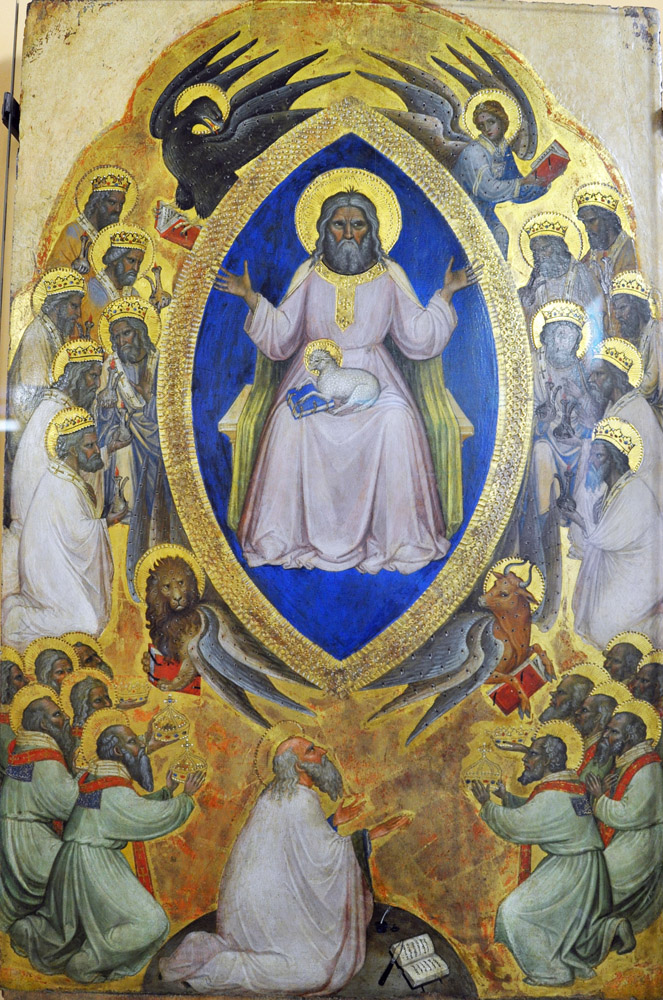 he that sat, was to the sight like the jasper and the sardine stone; and there was a rainbow round about the throne, in sight like unto an emerald. And round about the throne were four and twenty seats; and upon the seats, four and twenty ancients sitting, clothed in white garments, and on their heads were crowns of gold. And from the throne proceeded lightnings, and voices, and thunders; and there were seven lamps burning before the throne, which are the seven spirits of God. And in the sight of the throne was, as it were, a sea of glass like to crystal; and in the midst of the throne, and round about the throne, were four living creatures, full of eyes before and behind. And the first living creature was like a lion: and the second living creature like a calf: and the third living creature, having the face, as it were, of a man: and the fourth living creature was like an eagle flying.
he that sat, was to the sight like the jasper and the sardine stone; and there was a rainbow round about the throne, in sight like unto an emerald. And round about the throne were four and twenty seats; and upon the seats, four and twenty ancients sitting, clothed in white garments, and on their heads were crowns of gold. And from the throne proceeded lightnings, and voices, and thunders; and there were seven lamps burning before the throne, which are the seven spirits of God. And in the sight of the throne was, as it were, a sea of glass like to crystal; and in the midst of the throne, and round about the throne, were four living creatures, full of eyes before and behind. And the first living creature was like a lion: and the second living creature like a calf: and the third living creature, having the face, as it were, of a man: and the fourth living creature was like an eagle flying.
As in the Whore of Babylon panel, the artist suppresses details that would detract from the dignity of the scene. Still, he manages to include the 24 ancients with their white robes and crowns, the throne, and the four "living creatures," realized as the conventional symbols of the four evangelists with the books they have written. The golden mandorla does a fair job of standing in for the "lightnings, and voices, and thunders" of the text. At the bottom, St. John kneels before the throne. At his knees are his pen, ink, penknife, and book.
View full resolution
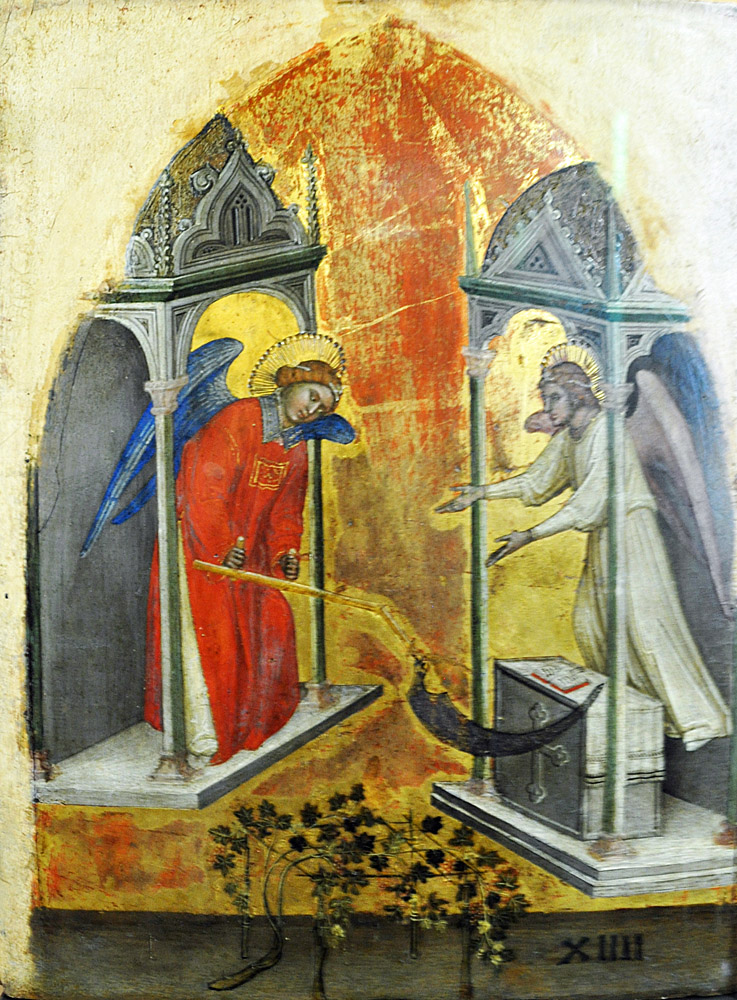 out from the altar, who had power over fire; and he cried with a loud voice to him that had the sharp sickle, saying: Thrust in thy sharp sickle, and gather the clusters of the vineyard of the earth; because the grapes thereof are ripe. And the angel thrust in his sharp sickle into the earth, and gathered the vineyard of the earth, and cast it into the great press of the wrath of God.
out from the altar, who had power over fire; and he cried with a loud voice to him that had the sharp sickle, saying: Thrust in thy sharp sickle, and gather the clusters of the vineyard of the earth; because the grapes thereof are ripe. And the angel thrust in his sharp sickle into the earth, and gathered the vineyard of the earth, and cast it into the great press of the wrath of God.
The artist treats the two verses quite literally, showing us the temple from which the first angel emerges, his sickle, the second angel and his altar, and the ripe grapes below. The altar is of course imagined as a Christian eucharistic altar. The "xiiii" in the lower right corner refers to chapter "14" of the Book of Revelation. Thus we have two panels picturing the Last Judgment on either side of the central vision of heavenly glory.
View full resolution.
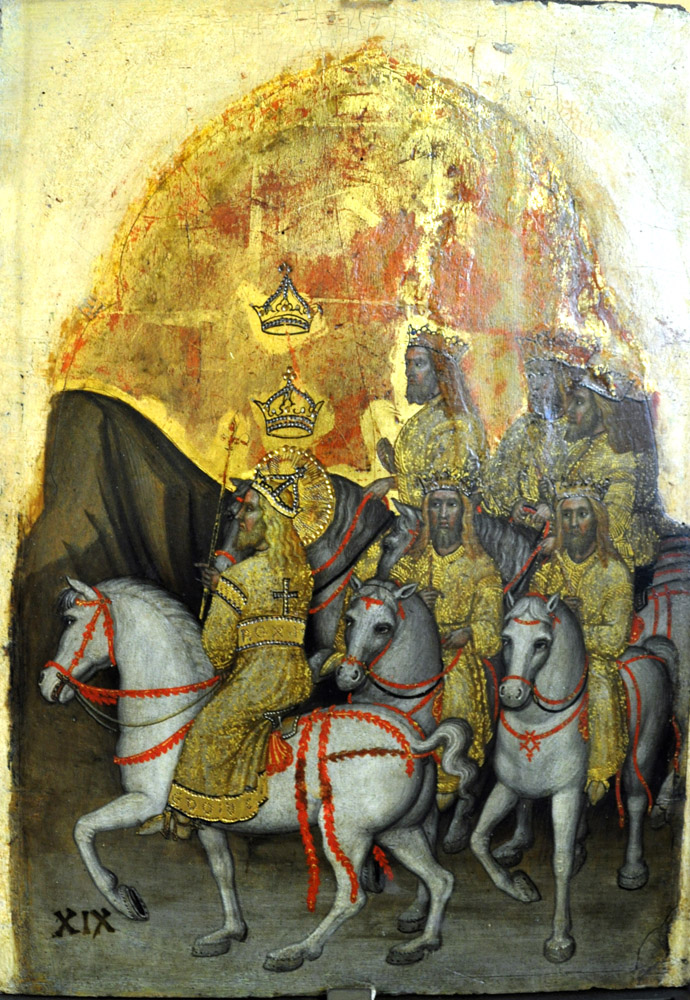 with him that sat upon the horse [i.e., the one identified in verse 13 as "The Word of God"] and with his army.
with him that sat upon the horse [i.e., the one identified in verse 13 as "The Word of God"] and with his army.
Like the panels directly left and right of the central image, the two outer panels present a complementary vision. The "kings of the earth" shown here are the ones who in 17:2 "have had fornication" with the Whore of Babylon pictured on the opposite panel. Each panel thus focuses on the "whorishness" of this world and its rulers.
View full resolution.
Images photographed at the Accademia Gallery, Venice, by Richard Stracke, shared under Attribution-NonCommercial-ShareAlike license.
